These Low Calorie Mashed Potatoes are made by cleverly blending cauliflower and potatoes together. This easy mashed potatoes recipe is light on calories but with tons of flavor!
If you have any leftover mashed potatoes, be sure to check out my air fryer mashed potato balls recipe!

Jump to:
Check out my Low Calorie French Toast and my Low Calorie Cheese Sauce for more low calorie recipes!
Light And Healthy Mashed Potatoes
These low calorie mashed potatoes are made by blending the goodness of cauliflower with the heartiness of potatoes. It's just as amazing as traditional mashed potatoes, but without the need for whole milk, heavy cream or cream cheese.
This classic side dish has great flavor and pairs perfectly with your holiday meals. They are the best mashed potatoes and are a delicious side dish!
How Many Calories Are In Mashed Potatoes?
Typically, when you make mashed potatoes at home, a ½ cup serving packs around 115 calories. But this lighter rendition? It's just 50 calories for that same ½ cup portion.

Why You'll Love This Recipe
- These creamy mashed potatoes are the perfect side dish for your holiday table. It pairs perfectly with your main dish!
- Thanks to low fat milk, you still get the creamiest mashed potatoes.
- Whether you're a fan of chunky or smooth mashed potatoes, the good news is this recipe lets you tailor the texture to your liking.
Ingredients You'll Need

- Cauliflower: Lends its mild flavor and creamy texture, contributing to the mashed potato consistency.
- Russet Potatoes: Provides that classic potato taste and contribute to the texture.
- Skim Milk: Brings the velvety quality that you expect in mashed potatoes.
- Olive Oil: Adds richness and depth. You can also use a small amount of butter.
- Garlic: Delivers a taste that elevates the dish from ordinary to extraordinary.
- Salt & Black Pepper: Enhance the flavors.
- Fresh Chives or Parsley (optional): Adding a sprinkle of fresh chives or parsley as a garnish adds a pop of color.
Step-By-Step Instructions
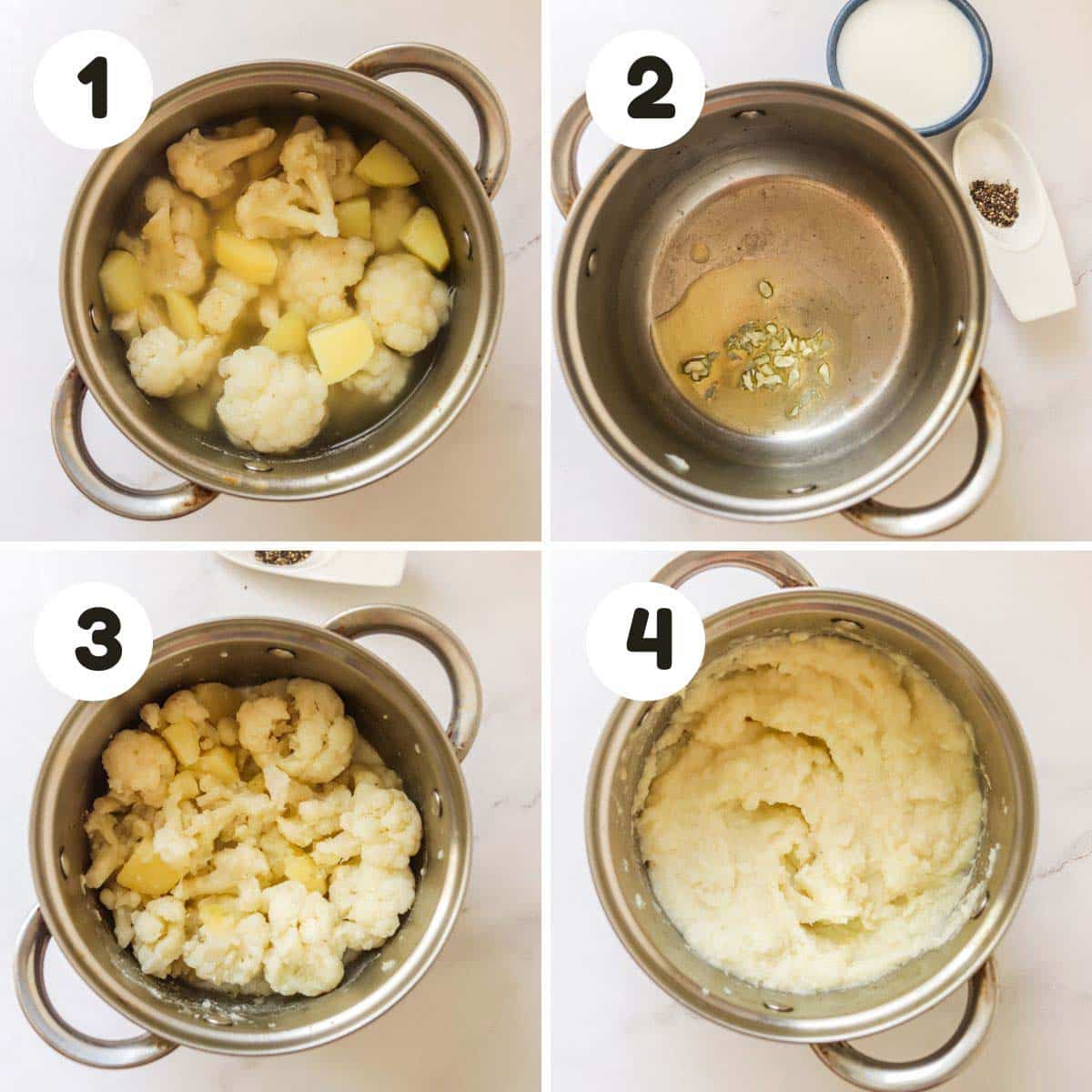
Step 1: In a large pot, bring water to a boil over high heat. Place potatoes and the cauliflower florets in the boiling water. Cook them together until they are tender, about 15-20 minutes. You can check their doneness by inserting a fork into them; they should be easily pierced.
Step 2: Drain the cauliflower and potatoes thoroughly in a colander.
Step 3: In the same pot, heat the milk and olive oil over low heat. Add the minced garlic and cook for about 1 minute, stirring constantly, until the garlic becomes fragrant.
Step 4: Add the drained cauliflower and potatoes back into the pot. Mash them using a potato masher or a fork until they reach your desired consistency. If you prefer a smoother texture, you can use a hand mixer or food processor, but avoid overprocessing to prevent a gluey texture.
Step 5: Season with salt and pepper, to taste. Stir with a wooden spoon.
Step 6: Serve immediately, garnished with fresh herbs, if desired.
NOTE: You can print the FULL recipe with all ingredients & detailed instructions below!

Expert Tips
- When boiling the cauliflower and potatoes, be sure to cook them until they're fork tender. Overcooking can lead to a watery mash.
- If you're adding herbs, spices, or additional seasonings, add them at the end of the mashing process. This way you can adjust the flavors without overmixing.
- Mashed potatoes are best served warm. If needed, gently reheat them over low heat, adding a splash of milk to maintain their creamy texture.
Variations
- Greek Yogurt: Replace some or all of the milk with nonfat plain Greek yogurt. Greek yogurt adds creaminess, and tanginess without adding many calories.
- Broth: Instead of using milk, you can use low-sodium vegetable broth, chicken broth or chicken stock to add moisture and flavor.
- Cottage Cheese: Blend in low-fat cottage cheese for added creaminess and protein. You can also use low-fat sour cream.
- Parmesan: Stir in some grated Parmesan before serving.
Storing & Freezing
Storing: If you plan to consume the mashed potatoes within a few days, store them in an airtight container in the refrigerator. They'll last for about 3 to 5 days.
Freezing: Allow the mashed potatoes to cool completely before freezing. Divide the mashed potatoes into individual serving portions or store them in larger batches, depending on your future needs. Portioning makes it easier to thaw only what you plan to use. Place the mashed potatoes in airtight containers or freezer safe resealable plastic bags. Mashed potatoes can be stored in the freezer for up to 2 to 3 months.
Recipe FAQ's
Use low-fat milk or unsweetened almond milk along with a small amount of olive oil. The cauliflower and potatoes themselves also contribute to the creamy texture.
Absolutely! While russet potatoes are commonly used for mashed potatoes, white potatoes, Yukon Gold potatoes, red potatoes and sweet potatoes all work.
No, the cauliflower flavor is usually mild and blends well with the potatoes.
Make sure to drain the cooked cauliflower and potatoes thoroughly after boiling. Excess moisture can lead to watery mashed potatoes.
More Low Calorie Recipes You'll Love

Low Calorie Mashed Potatoes
Special Equipment
Ingredients
- 1 medium head of cauliflower cut into florets
- 2 medium russet potatoes peeled and cut into chunks
- ¼ cup skim milk
- 1 tablespoon olive oil
- 2 cloves garlic minced
- Salt and black pepper, to taste
- Fresh chives or parsley, for garnish optional
Instructions
- In a large pot, bring water to a boil over high heat. Place potatoes and the cauliflower florets in the boiling water. Cook them together until they are tender, about 15-20 minutes. You can check their doneness by inserting a fork into them; they should be easily pierced.
- Drain the cauliflower and potatoes thoroughly in a colander.
- In the same pot, heat the milk and olive oil over low heat. Add the minced garlic and cook for about 1 minute, stirring constantly, until the garlic becomes fragrant.
- Add the drained cauliflower and potatoes back into the pot. Mash them using a potato masher or a fork until they reach your desired consistency. If you prefer a smoother texture, you can use a hand blender or food processor, but avoid overprocessing to prevent a gluey texture.
- Season with salt and pepper, to taste. Stir with a wooden spoon.
- Serve immediately, garnished with fresh herbs, if desired.
Notes
- When boiling the cauliflower and potatoes, be sure to cook them until they're fork tender. Overcooking can lead to a watery mash.
- If you're adding herbs, spices, or additional seasonings, add them at the end of the mashing process. This way you can adjust the flavors without overmixing.
- Mashed potatoes are best served warm. If needed, gently reheat them over low heat, adding a splash of milk to maintain their creamy texture.
- Storing: If you plan to consume the mashed potatoes within a few days, store them in an airtight container in the refrigerator. They'll last for about 3 to 5 days.
- Freezing: Allow the mashed potatoes to cool completely before freezing. Divide the mashed potatoes into individual serving portions or store them in larger batches, depending on your future needs. Portioning makes it easier to thaw only what you plan to use. Place the mashed potatoes in airtight containers or freezer safe resealable plastic bags. Mashed potatoes can be stored in the freezer for up to 2 to 3 months.
Nutrition
All nutritional information is based on third-party calculations and should be considered estimates. Actual nutritional content will vary with brands used, measuring methods, portion sizes and more.


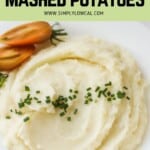
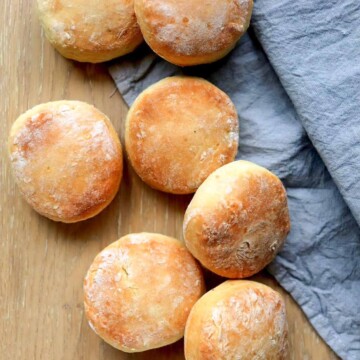
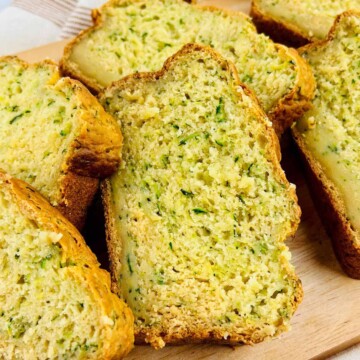


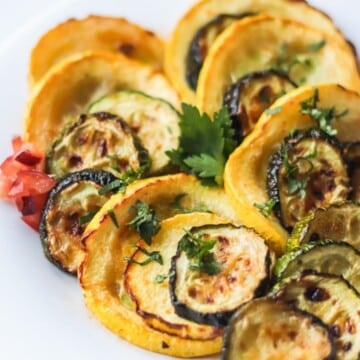

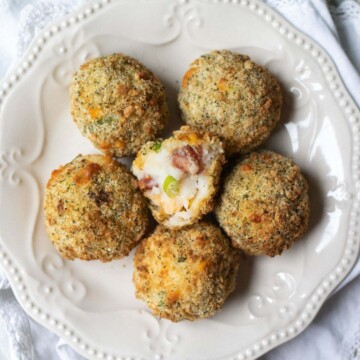
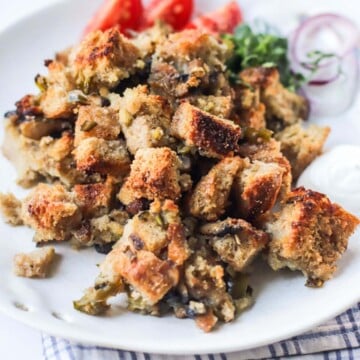
Comments
No Comments